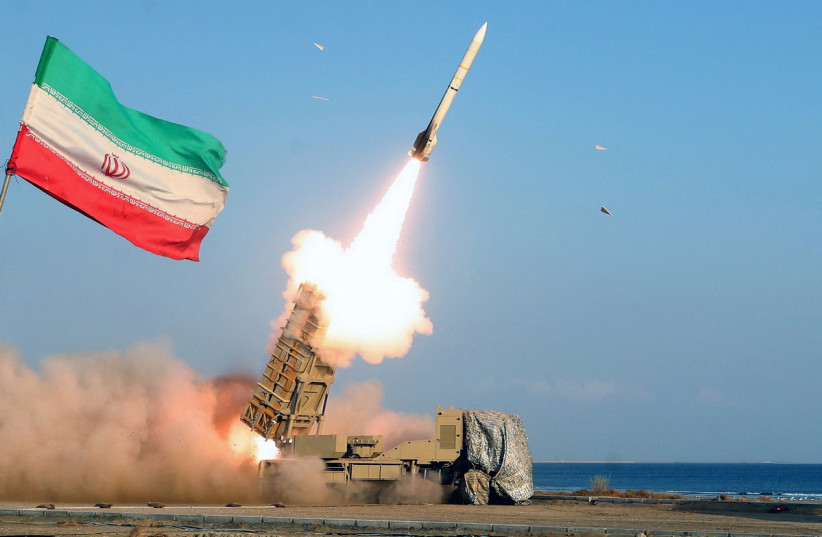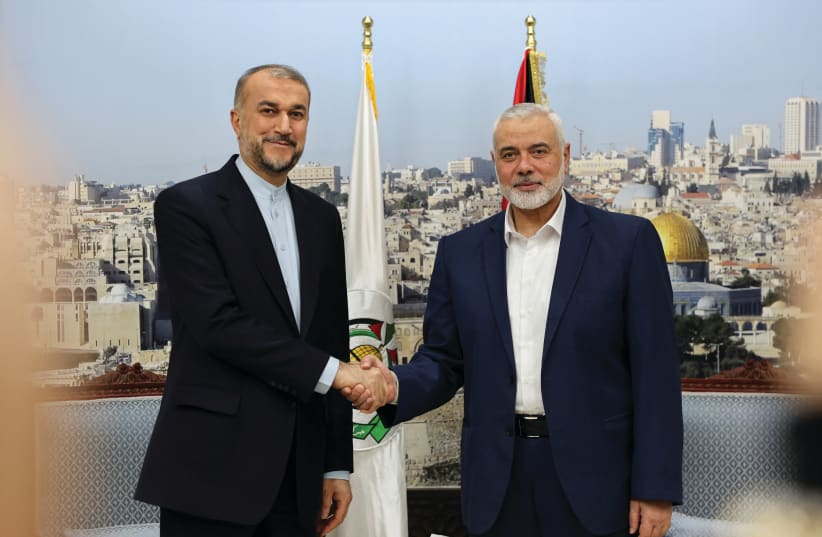“The only thing we have in common with the Israeli government is that we also don’t believe in the two-state solution.” The speaker was not an Israeli far-right activist, but Iranian Foreign Minister Hossein Amirabdollahian.
Addressing a December 2023 forum in Doha, he emphasized what is obvious to anyone concerned about Iran’s growing influence in the region – Israel’s refusal to discuss a political solution with the Palestinians is a boon for the leadership in Tehran. It serves as a catalyst for expanding Iran’s influence and expelling Israel from the region.
This unwillingness poses a major obstacle to seizing the opportunity of the October 7 and April 13 attacks on Israel to forge a regional alliance against Iran.
Iran’s combined missile and drone attack on Israel should have dealt a significant blow to Iran and its regional standing. It could even serve as a turning point in regional and global determination to confront the threat it poses, as it stands on the cusp of nuclear capacity. The offensive provides a clear illustration for the United States and the countries of the region of the need for a joint stand against a more aggressive, violent, and destabilizing Iran. This is an opportunity to turn the Iranian proxy network from an asset into a liability for Iran in the regional arena – to further overstretch Iran on multiple fronts.
The Gaza war has exacerbated the clash within the commitment of Iran’s Arab allies to Tehran’s directives and the interests of these host/captive countries. The growing criticism in Lebanon of Hezbollah’s involvement in the Israel-Hamas war, and the Assad administration’s refusal to allow an Iranian attack on Israel from its territory clearly illustrate these countries’ growing recognition of the price they pay for Iran’s intervention in their affairs.


Thus, the April 13 attack should serve as an impetus for an Israeli-regional alliance against Iran with American and international, and especially regional, support. The Gulf states whose airspace was grossly violated by the Iranian missiles and drones were provided with strong evidence of the tangible nature of the Iranian threat. At the same time, the risk of the attack to regional stability is being compounded by Iran’s threats to block the Strait of Hormuz and shipping routes to the Red Sea. The Iranian threat thus directly affects the substantive interests of the international community. Iran has become, from an international perspective, a tangible regional threat with ripples that risk the stability in the Middle East and beyond. Ultimately, the attack increases the sense of urgency among the United States and Western countries of the need for a regional coalition.
However, the Gaza campaign has made clear that progress toward such a regional axis directly depends on Israeli agreement to discuss resolution of the conflict with the Palestinians. Recent Saudi statements make clear that the price of forging public strategic ties with Israel has gone up and now includes political progress on the Palestinian front as a condition for normalization.
Israel's missed opportunity: Discussing a two-state solution
Israeli willingness to discuss a two-state political horizon could have dealt Iran a decisive blow, but Israel is at grave risk of squandering this opportunity. Instead of leveraging October 7 for open and enhanced security cooperation with Arab states, thereby turning Hamas’s cognitive victory into a strategic defeat for Iran and its proxies, the Israeli government is serving Iran’s goals. In a January article of rare sincerity, former Lebanese prime minister Fouad Siniora noted that regional hands are now reaching out to Israel, but Israel refuses to hold them.
Israel has celebrated the courageous regional participation of Jordan and other countries in the effort to defend it from Iran’s offensive. This rare moment of cooperation in the face of a common threat could create a false sense of renewed momentum in Arab-Israeli relations.
In fact, prospects of a renewed momentum are undermined by the deep frustration among current and potential partners in the region at Israel’s refusal to discuss the goals of the war. The April 13 cooperation obscured Israel’s deeply troubled relations with Jordan and the Gulf states and the implications for the future of cooperation vis-à-vis Iran.
It is important to distinguish between military-operational coordination under American auspices in the face of a specific attack, and the establishment of a regional, political, and public alliance against Iran’s regional and nuclear ambitions.
A joint regional coalition cannot exist solely on the basis of a shared threat; it must be based on a convergence of interests to promote a common political vision, or at least agreement on the strategic direction of the partnership.
A wide chasm separates Israeli government positions and the vision of regional partners from Saudi Arabia to Egypt. The danger of sliding into this chasm has become more real for Arab leaders since October 7.
Moreover, Iran’s attempts to erode the regional standing of Israel and the United States have deepened concern for the future relations between Israel and the region, let alone for a united front against Iran.
THUS, IRAN’S April 13 attack coincides with its broad political-diplomatic offensive since the start of the war aimed at redefining the strategic balance of power in the Middle East by eroding Israeli and American influence in order to strengthen its own.
The Iranians are exploiting the war in order to roll back the assets Israel acquired through the Abraham Accords and reverse it to the status of a regional pariah. Iran’s move focuses on pressuring key countries to cancel or at least reduce diplomatic ties with the Zionist regime.
The intensive shuttle diplomacy by Iran’s foreign minister illustrates the map of Iranian interests. His schedule included a visit to India, a key component of the American-Gulf-Israeli alliance promoted by President Biden, ongoing contacts with the Saudis, frequent coordination meetings with Turkish President Recep Tayyip Erdogan, and a call to sever Ankara’s economic relations with Israel.
The Iranian effort has had very limited success so far. Specifically, there is no evidence that it has had a direct impact on Saudi motivation to halt normalization or on Turkey’s decision to limit the scope of trade with Israel.
However, combined with Israel’s inability to present clear goals for the devastating war in Gaza, Iran’s effort could bear fruit, as Israel’s status erodes and its short-sighted failures become apparent to all.
The solid foundation of the Abraham Accords for the UAE and Bahrain was Israel’s integration into a long-term regional process that would provide security and economic stability. The war exposed Israel as a regional power firing from the hip, driven by political compromises with the far Right, rather than by a long-term perspective. It exposed to the Emiratis, Saudis, and Bahrainis the gaps between their own long-term thinking and Israel’s inability to think beyond the tactical military level and short-term political maneuvering.
This is exactly the vacuum Iran is targeting. The first sign of Iranian success has emerged in the weakest link of the normalization countries – Sudan. On October 9, Abdel Fattah al-Burhan’s government renewed diplomatic relations with Iran in order to obtain weapons for its war against a rival faction. This is a classic Iranian method familiar from Yemen and Syria – Iran identified an opportunity, a political vacuum created by a civil war in a country of strategic value, and filled it.
Iran’s effort to exploit the Gaza war in order to expel Israel from the region is not only interstate-oriented. It also exploits public anger in the Arab world against Israel over the protracted war in Gaza and the worsening humanitarian crisis there. The return of the resistance narrative allows Iran to ride the wave of sympathy for its allies – especially the Houthis in Yemen.
In the face of the ineffectual response by Arab states, Iran and its allies are portrayed as the only supporters of the Palestinian struggle in the current destructive war. Its efforts are also fueled by a desire to portray Iran on the regional and global stage as a representative of the struggle against American colonization in the Middle East, rather than a foreign Shi’ite interloper in the Sunni Arab world.
The April 13 attack – despite its failure – is likely to be accepted in parts of the Arab world as evidence of Iran’s commitment to this struggle.
Israel’s research institutes and policy planners have dealt for an entire decade with the question of which threat is more dangerous – the Iranian or Palestinian. As expected, we were all wrong. The threats are intertwined and inseparable.
By weakening relatively moderate Palestinian elements and bolstering Hamas; eroding the fragile relations with Jordan and Egypt; creating a humanitarian crisis in Gaza and fomenting public anger in the Arab world, and stubbornly refusing to present a political vision for the “day after,” we are opening the door to greater Iranian influence in the region.
Nature abhors a vacuum, and the Middle East is no exception. The Iranians are experts at seizing opportunities created by extremism and conflict.
As long as we keep moving without a strategic vision, we are providing the Iranians with optimal conditions for influence.
Thus, while we prepare for direct war against Iran and its allies, the far-right architects of Israel’s colossal October 7 failure serve Iran’s strategic interests. Iranian Supreme Leader Ali Khamenei and President Ebrahim Raisi could not have hoped for such predictable and effective allies as Bezalel Smotrich and Itamar Ben-Gvir.
Throughout this damned campaign, Israel has demonstrated once again that it never misses an opportunity to miss an opportunity.
The writer is the CEO of Mitvim: The Israeli Institute for Regional Foreign Policies.
